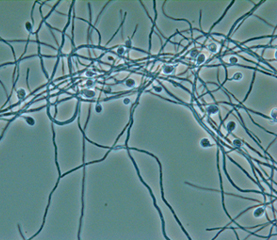Biology of Frankia Frankia sp. strains comprise a distinct lineage among the high Mol% G+C Gram positive Actinobacteria . They are filamentous "euactinomycetes" that grow by hyphal branching and tip extension and thus resemble the antibiotic-producing Streptomyces sp. Frankiae are developmentally complex, producing three cell types during growth: vegetative hyphae, sporangiospores and lipid-enveloped cellular structures known as "vesicles". The latter develop during N-starvation and contain the O2-labile nitrogenase. In symbiosis, they supply sufficient combined nitrogen so that the plant can grow without added nitrogen. Physiologically, Frankia strains grow slowly in defined nutrient media. They grow best on short-chain fatty acids, dicarboxylic acids or other low MW organic acids (propionate, succinate, pyruvate, etc.) plus ammonia, or N2, as the nitrogen source. Some strains grow on simple sugars. Frankiae thus have all housekeeping genes necessary for saprophytic existence plus genes for sporulation, vesicle development, symbiosis, N2 fixation and secondary metabolite production. Frankia sp. strain HFPCcI3 was isolated in 1983 at Harvard Forest in John Torrey's lab by Zhang Zhongze. HFPCcI3 grows slowly on organic acids such as propionate or pyruvate and will grow on some complex media. It is resistant to kanamycin and, like many actinomycetes, to nalidixic acid. Its ultrastructure has been studied both with respect to its free-living existence and its presence in nodules of Casuarina sp. HFPCcI3 belongs to a group of closely related strains that nodulate Casuarina and Allocasuarina spp. The Casuarinaceae is a tropical family of trees and shrubs whose natural range includes Australia and the Melanesian region of the Pacific. They have been planted on islands and in coastal regions of the Indian Ocean, New Zealand, Africa and North and South America, especially in the Caribbean islands, Florida and California where they have been used for soil stabilization, as windbreaks and for lumber and firewood. The Global Importance of the Actinorhizal Symbiosis The importance of Frankia sp. strains derives from their ability to form nitrogen-fixing root nodule symbioses on certain woody angiosperms, termed "actinorhizal plants". Actinorhizal plants are classified in eight plant families, 24 genera and more than 200 species. These symbioses add a large proportion of new nitrogen to several ecosystems . They constitute the major N 2 -fixing symbioses in temperate forests ( Alnus ), dry chaparral and matorral ( Ceanothus, Trevoa, Talguenea, Chamaebatia, Cercocarpus, Purshia ), coastal dunes ( Casuarina, Myrica, Hippophae ), alpine communities ( Alnus ) and in colder regions ( Alnus, Dryas ) such as in Scandinavia, Canada, Alaska or New Zealand where legumes are insignificant or absent. Actinorhizal symbioses are thus key to establishing and maintaining many forests and shrublands, particularly on occasions where climatic or anthropogenic changes disrupt ecosystems. For more information see: http://web.uconn.edu/mcbstaff/benson/Frankia/FrankiaHome.htm# Relevant Publications Benson, D.R. and W.B. Silvester, Biology of Frankia strains, actinomycete symbionts of actinorhizal plants. Microbiol. Rev., 1993. 57 : p. 293-319. Zhang, Z., M.F. Lopez, and J.G. Torrey, A comparison of cultural characteristics and infectivity of Frankia isolates from root nodules of Casuarina species. Plant and Soil, 1984. 78 : p. 79-90. |
||
|
||
Frankia sp. CcI3

